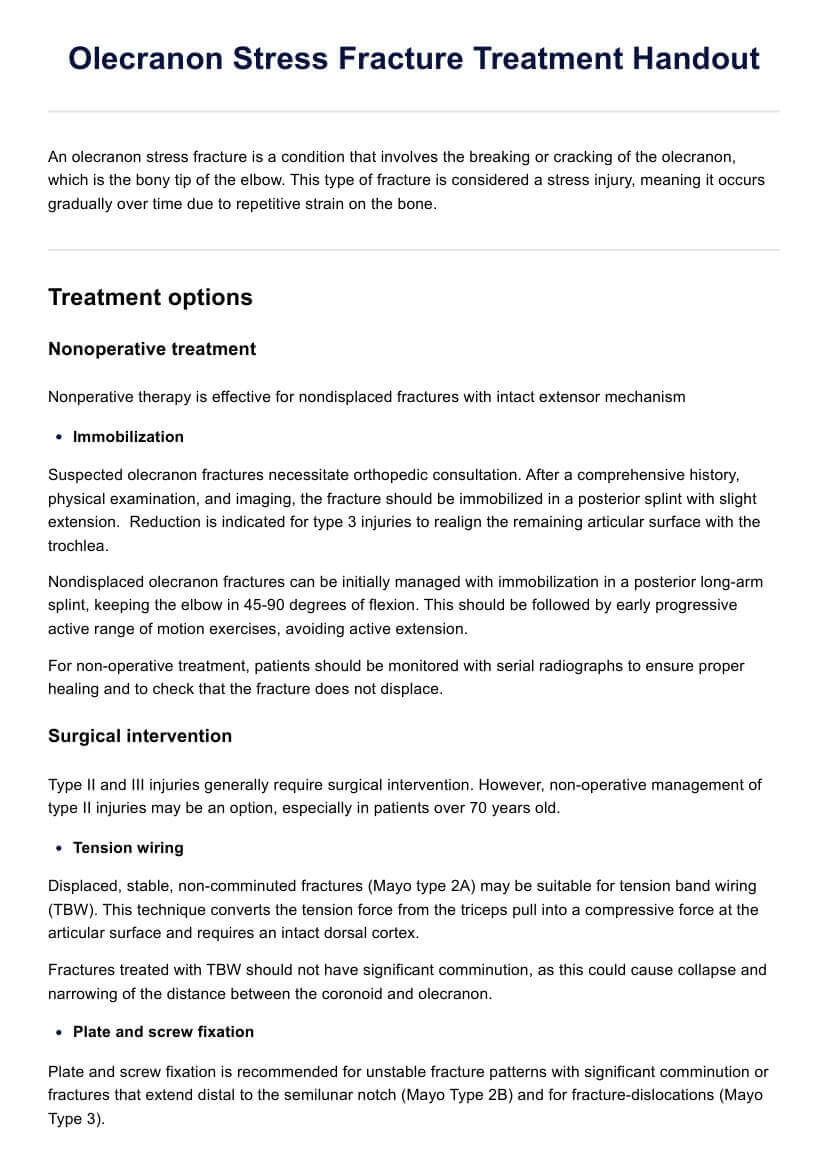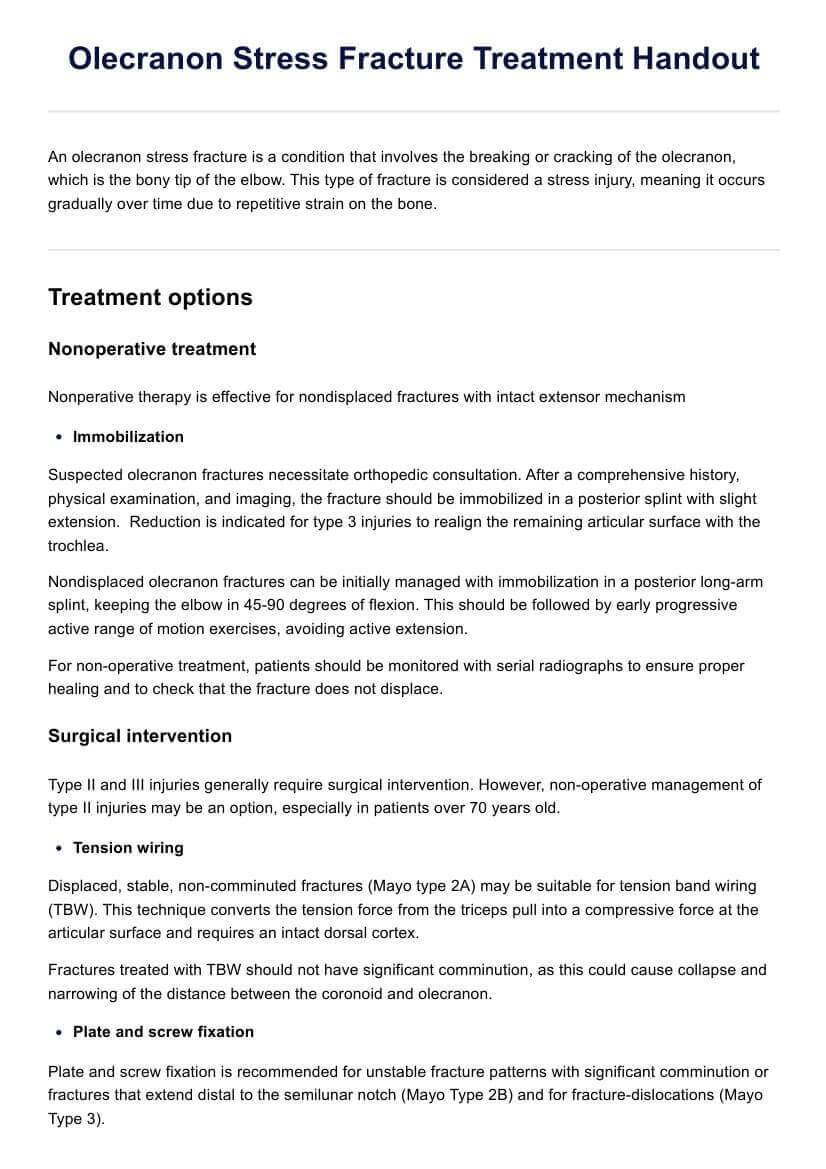Olecranon Stress Fracture Treatment Handout
Learn effective management strategies for olecranon stress fractures with our comprehensive treatment handout, covering nonoperative and surgical options.


What is an olecranon stress fracture?
An olecranon stress fracture occurs in the bony prominence of the ulna at the elbow and is commonly seen in athletes who engage in repetitive throwing or weightlifting activities. This type of fracture is characterized by localized pain and swelling at the back of the elbow, exacerbated by movements such as flexion, extension, and rotation of the forearm. The condition results from repetitive stress and overuse rather than a single traumatic event. Treatment typically involves rest and immobilization to achieve pain relief and allow natural healing. In cases where the fracture does not heal with conservative management, surgical treatment, such as internal fixation, may be necessary to restore function and stability to the elbow.
Olecranon stress fractures are often caused by repetitive overuse activities that exert excessive stress on the elbow, such as throwing sports or weightlifting. These activities lead to microtrauma and eventual fractures in the olecranon. Symptoms include localized pain at the posterior elbow, swelling, and decreased range of motion, particularly affecting the movement of the elbow and rotation of the forearm. Pain relief is a primary goal in managing these fractures, often necessitating a combination of rest, physical therapy, and, in some cases, surgical intervention to address internal fixation needs and ensure proper healing.
Olecranon Stress Fracture Treatment Handout Template
Olecranon Stress Fracture Treatment Handout Sample
How to treat olecranon stress fractures
When the elbow experiences extreme abuse, it is prone to developing olecranon stress fractures, particularly in athletes who engage in repetitive overhead activities. This stress fracture can happen when the bones radius and ulna endure excessive forces, leading to small cracks in the olecranon. Although some cases can be healed solely through nonsurgical treatments, others may require surgical intervention to ensure proper recovery.
Nonoperative therapy
Nonoperative therapy is effective for nondisplaced fractures with intact extensor mechanisms. This approach involves immobilizing the elbow, followed by gradual mobilization to prevent stiffness. It is particularly suitable for elderly patients or those with significant medical conditions, often resulting in satisfactory outcomes and high patient satisfaction.
Surgical treatment
Surgical treatment is necessary for fractures with significant displacement, loss of active extension, or instability. Various techniques are used, including:
- Tension-band wiring: This method is effective for simple fractures and involves using a wire loop to hold the bone fragments together.
- Plate fixation: Suitable for more complex fractures, this technique uses metal plates and screws to stabilize the bone.
- Intramedullary screw fixation: This method is used for specific fracture types, offering stability and promoting healing.
Postoperative care
Postoperative care focuses on early mobilization to prevent stiffness. Patients are typically able to return to vigorous activities within 3-4 months post-surgery. Complications such as symptomatic hardware, nonunion, and infection may occur, often necessitating secondary surgery for hardware removal.
For a comprehensive assessment, download our doctor questionnaire to help guide treatment decisions, considering the ligaments, nerves, and tendons crossing behind the elbow, which make it a pivot and hinge joint critical for forearm function (Rabin, 2019).
How to use our treatment guidelines handout template?
Healthcare professionals, including orthopedic specialists and physical therapists, can effectively utilize our comprehensive treatment guidelines handout for managing olecranon stress fractures. This resource is essential when addressing fractures at the bony prominence behind the elbow, commonly caused by repetitive stress or overuse in athletes. Here are the steps to use the handout:
- Assess fracture severity: Determine if the fracture is non-displaced, minimally displaced, or if more severe options have been exhausted. Use the Olecranon Fracture Classification Table to determine the type of stress fracture.
- Choose treatment approach: Decide between nonoperative therapy, including rest, immobilization, pain management, and physical therapy, or surgical procedures like open reduction and internal fixation.
- Implement treatment plan: Based on the handout, create a treatment for olecranon stress fracture. Make sure to consider the type of fracture severity, age of the patient and any other relevant factors.
- Monitor healing progress: Regularly evaluate with radiographic imaging to assess fracture healing and watch for signs of complications such as infection or hardware issues.
- Adjust as needed: Modify the treatment plan as the patient progresses, transitioning from immobilization to rehabilitation exercises to restore function gradually.
This handout is designed to guide healthcare professionals through a structured approach to treating olecranon stress fractures, ensuring optimal recovery and return to functionality for patients.
Benefits of using this handout
Using our Olecranon Stress Fracture Treatment Guidelines Handout PDF offers several benefits to healthcare professionals specializing in olecranon injuries, particularly athletes who apply extreme abuse and overuse.
- Structured approach: Our handout provides a structured framework for assessing and treating olecranon stress fractures, ensuring consistent and thorough patient care.
- Comprehensive guidance: It covers both nonoperative and surgical procedures, offering a range of treatments for olecranon stress fractures based on fracture severity and patient needs.
- Enhanced patient education: The handout facilitates clear communication with patients, explaining treatment protocols and expected outcomes effectively, especially for athletes who apply extreme abuse and overuse.
- Timely intervention: By following outlined protocols, healthcare providers can initiate timely interventions, minimizing complications such as pain relief has occurred surgery and promoting faster recovery.
- Professional development: It serves as a valuable reference for continuing education, keeping healthcare professionals updated on best practices in orthopedic care, including where collateral ligaments are located
Commonly asked questions
Diagnosis involves a clinical examination and imaging studies such as X-rays or MRI scans to assess the severity and displacement of the fracture.
Nonoperative treatment includes rest, activity modification, immobilization with a sling or splint, pain management, and physical therapy to regain strength and mobility.
Surgery is recommended for displaced fractures, unstable fractures, or when nonoperative treatments fail to promote healing effectively.







































































































